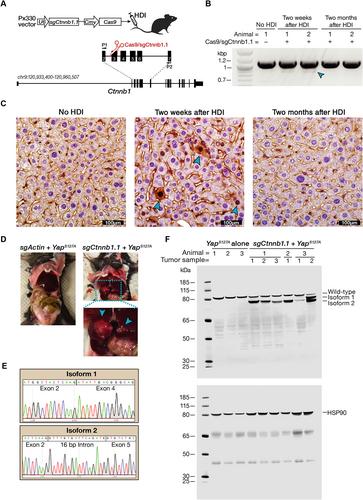Haiwei Mou, Onur Eskiocak, Kadir A. Özler, Megan Gorman, Junjiayu Yue, Ying Jin, Zhikai Wang, Ya Gao, Tobias Janowitz, Hannah V. Meyer, Tianxiong Yu, John E Wilkinson, Alper Kucukural, Deniz M. Ozata, Semir Beyaz
下载PDF
{"title":"CRISPR-induced exon skipping of β-catenin reveals tumorigenic mutants driving distinct subtypes of liver cancer","authors":"Haiwei Mou, Onur Eskiocak, Kadir A. Özler, Megan Gorman, Junjiayu Yue, Ying Jin, Zhikai Wang, Ya Gao, Tobias Janowitz, Hannah V. Meyer, Tianxiong Yu, John E Wilkinson, Alper Kucukural, Deniz M. Ozata, Semir Beyaz","doi":"10.1002/path.6054","DOIUrl":null,"url":null,"abstract":"<p>CRISPR/Cas9-driven cancer modeling studies are based on the disruption of tumor suppressor genes by small insertions or deletions (indels) that lead to frame-shift mutations. In addition, CRISPR/Cas9 is widely used to define the significance of cancer oncogenes and genetic dependencies in loss-of-function studies. However, how CRISPR/Cas9 influences gain-of-function oncogenic mutations is elusive. Here, we demonstrate that single guide RNA targeting exon 3 of <i>Ctnnb1</i> (encoding β-catenin) results in exon skipping and generates gain-of-function isoforms <i>in vivo</i>. CRISPR/Cas9-mediated exon skipping of <i>Ctnnb1</i> induces liver tumor formation in synergy with YAP<sup>S127A</sup> in mice. We define two distinct exon skipping-induced tumor subtypes with different histological and transcriptional features. Notably, ectopic expression of two exon-skipped β-catenin transcript isoforms together with YAP<sup>S127A</sup> phenocopies the two distinct subtypes of liver cancer. Moreover, we identify similar <i>CTNNB1</i> exon-skipping events in patients with hepatocellular carcinoma. Collectively, our findings advance our understanding of β-catenin-related tumorigenesis and reveal that CRISPR/Cas9 can be repurposed, <i>in vivo</i>, to study gain-of-function mutations of oncogenes in cancer. © 2023 The Authors. <i>The Journal of Pathology</i> published by John Wiley & Sons Ltd on behalf of The Pathological Society of Great Britain and Ireland.</p>","PeriodicalId":232,"journal":{"name":"The Journal of Pathology","volume":"259 4","pages":"415-427"},"PeriodicalIF":5.6000,"publicationDate":"2023-01-15","publicationTypes":"Journal Article","fieldsOfStudy":null,"isOpenAccess":false,"openAccessPdf":"https://pathsocjournals.onlinelibrary.wiley.com/doi/epdf/10.1002/path.6054","citationCount":"1","resultStr":null,"platform":"Semanticscholar","paperid":null,"PeriodicalName":"The Journal of Pathology","FirstCategoryId":"3","ListUrlMain":"https://onlinelibrary.wiley.com/doi/10.1002/path.6054","RegionNum":2,"RegionCategory":"医学","ArticlePicture":[],"TitleCN":null,"AbstractTextCN":null,"PMCID":null,"EPubDate":"","PubModel":"","JCR":"Q1","JCRName":"ONCOLOGY","Score":null,"Total":0}
引用次数: 1
引用
批量引用
Abstract
CRISPR/Cas9-driven cancer modeling studies are based on the disruption of tumor suppressor genes by small insertions or deletions (indels) that lead to frame-shift mutations. In addition, CRISPR/Cas9 is widely used to define the significance of cancer oncogenes and genetic dependencies in loss-of-function studies. However, how CRISPR/Cas9 influences gain-of-function oncogenic mutations is elusive. Here, we demonstrate that single guide RNA targeting exon 3 of Ctnnb1 (encoding β-catenin) results in exon skipping and generates gain-of-function isoforms in vivo . CRISPR/Cas9-mediated exon skipping of Ctnnb1 induces liver tumor formation in synergy with YAPS127A in mice. We define two distinct exon skipping-induced tumor subtypes with different histological and transcriptional features. Notably, ectopic expression of two exon-skipped β-catenin transcript isoforms together with YAPS127A phenocopies the two distinct subtypes of liver cancer. Moreover, we identify similar CTNNB1 exon-skipping events in patients with hepatocellular carcinoma. Collectively, our findings advance our understanding of β-catenin-related tumorigenesis and reveal that CRISPR/Cas9 can be repurposed, in vivo , to study gain-of-function mutations of oncogenes in cancer. © 2023 The Authors. The Journal of Pathology published by John Wiley & Sons Ltd on behalf of The Pathological Society of Great Britain and Ireland.
crispr诱导的β-catenin外显子跳变揭示了驱动不同亚型肝癌的致瘤突变
CRISPR/ cas9驱动的癌症建模研究是基于肿瘤抑制基因被小的插入或缺失(indel)破坏,从而导致帧移突变。此外,在功能丧失研究中,CRISPR/Cas9被广泛用于定义癌症致癌基因的意义和遗传依赖性。然而,CRISPR/Cas9如何影响功能获得性致癌突变是难以捉摸的。在这里,我们证明了靶向Ctnnb1(编码β-catenin)的外显子3的单个引导RNA导致外显子跳跃并在体内产生功能获得异构体。CRISPR/ cas9介导的Ctnnb1外显子跳变与YAPS127A协同作用诱导小鼠肝脏肿瘤形成。我们定义了两种不同的外显子跳过诱导的肿瘤亚型,具有不同的组织学和转录特征。值得注意的是,两个外显子跳过的β-catenin转录异构体与YAPS127A的异位表达反映了两种不同亚型的肝癌。此外,我们在肝细胞癌患者中发现了类似的CTNNB1外显子跳变事件。总的来说,我们的发现促进了我们对β-catenin相关肿瘤发生的理解,并揭示了CRISPR/Cas9可以在体内被重新利用来研究癌症中癌基因的功能获得突变。©2023作者。《病理学杂志》由约翰·威利出版;儿子有限公司代表大不列颠及爱尔兰病理学会。
本文章由计算机程序翻译,如有差异,请以英文原文为准。


 求助内容:
求助内容: 应助结果提醒方式:
应助结果提醒方式:


